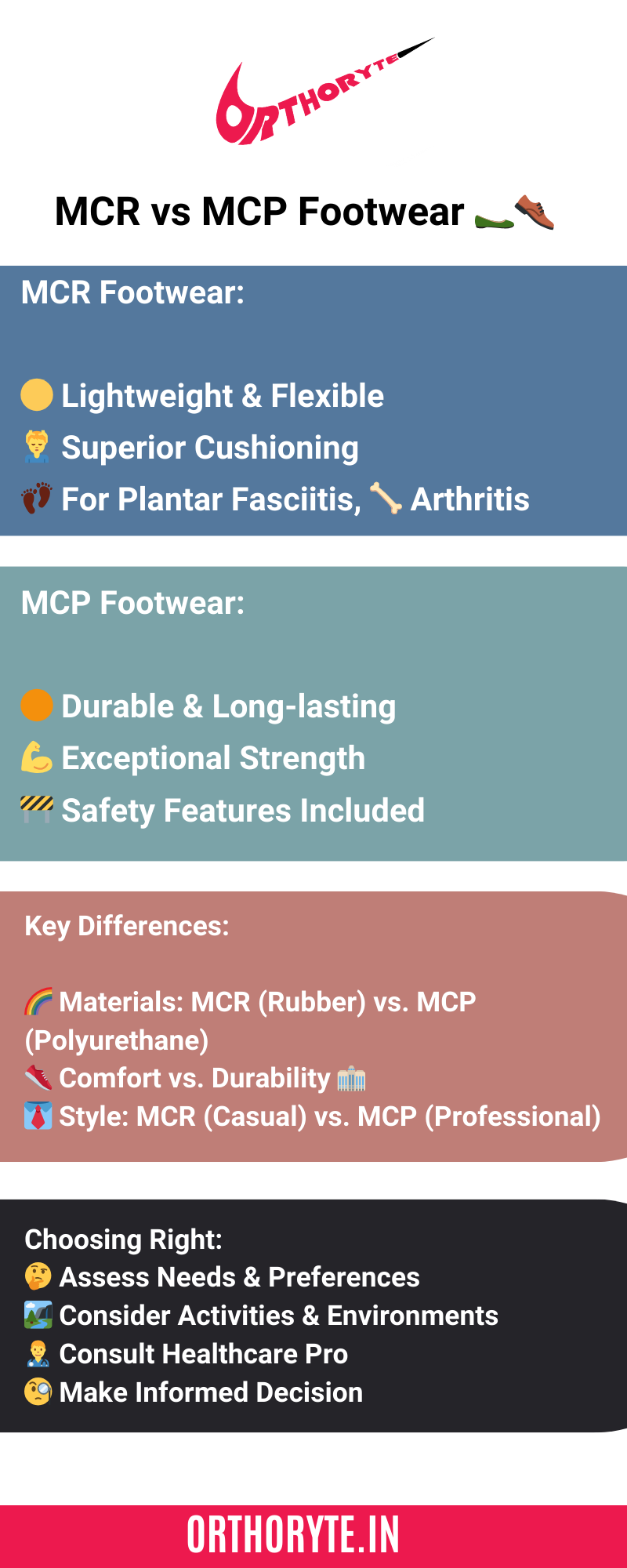
MCR vs MCP Footwear - Which is Best for You?
When it comes to orthopedic footwear, making the right choice is essential for both comfort and overall foot health. However, with the wide range of options available, it can be confusing to determine which type of shoe is best suited for your needs. In this article, we will explore the difference between MCR (Micro-Cellular Rubber) and MCP (Multiple Component Polyurethane) footwear to help you make an informed decision.
What is MCR footwear?
MCR footwear refers to shoes that are made from micro-cellular rubber, a lightweight and flexible material known for its cushioning properties. These shoes are carefully constructed using advanced techniques to provide optimal comfort and support to the wearer.
The components of MCR footwear are designed to promote a healthy and comfortable walking experience. The insoles are often anatomically shaped to support the natural contours of the foot, while the midsoles are engineered to absorb impact and reduce strain on joints. MCR footwear is particularly beneficial for individuals with foot conditions such as plantar fasciitis or arthritis, as it helps alleviate discomfort and provide relief.
What is MCP footwear?
On the other hand, MCP footwear stands for Multiple Component Polyurethane. This type of footwear is known for its durability and longevity. The components of MCP shoes are made from a combination of materials, including polyurethane, which offers exceptional strength and resistance to wear and tear.
MCP footwear is highly regarded for its protective features. The outsoles are designed to provide excellent traction and stability, making them suitable for various terrains and work environments. Additionally, many MCP shoes incorporate safety features such as toe caps or reinforced heels to safeguard the wearer from potential hazards. With a wide range of styles and designs available, MCP footwear offers versatility and aesthetic appeal.
Differences between MCR and MCP footwear
While both MCR and MCP footwear offer unique advantages, there are notable differences between the two.
Materials used: MCR footwear is primarily made from micro-cellular rubber, which provides superior cushioning and flexibility. In contrast, MCP footwear combines different components, including polyurethane, to offer durability and resilience.
Focus on foot conditions: MCR footwear is specifically designed to address foot conditions and promote comfort. It is often recommended for individuals with ailments such as plantar fasciitis, bunions, or sensitive feet. In contrast, MCP footwear focuses more on durability and protection, making it suitable for various work environments or outdoor activities.
Comfort vs. durability: MCR footwear excels in terms of comfort, with its cushioned insoles and shock-absorbing midsoles. It prioritizes the wearer's comfort and is ideal for those who spend long hours on their feet. MCP footwear, on the other hand, prioritizes durability and toughness, making it suitable for demanding work environments or rugged outdoor activities.
Style and design variations: While MCR footwear often features a more casual and sporty design, MCP footwear offers a wider range of style options. From sleek and professional-looking shoes to rugged and sturdy boots, MCP footwear provides versatility for different preferences and occasions.
Choosing the right footwear for you
To determine whether MCR or MCP footwear is best for you, several factors need to be considered.
Firstly, assess your personal needs and preferences. Consider the specific activities you engage in, as well as the environments you frequent. If you prioritize comfort and have foot conditions, MCR footwear may be the ideal choice. However, if you require durability and protection, especially in physically demanding jobs or outdoor adventures, MCP footwear may be more suitable.
Furthermore, consider any existing foot conditions or health concerns you may have. Consult with a podiatrist or healthcare professional who can provide guidance based on your specific requirements. They can help determine if MCR footwear's cushioning and support would benefit you or if MCP footwear's protective features are more appropriate.

Finally, understanding the difference between MCR and MCP footwear is crucial in selecting the right pair of shoes for your needs. MCR footwear excels in comfort and support, providing relief for foot conditions and promoting overall foot health. On the other hand, MCP footwear offers durability, protection, and versatility, making it suitable for demanding environments and various activities.
Ultimately, the choice between MCR and MCP footwear depends on your individual orthopaedic needs, preferences, and foot health. Take the time to evaluate these factors carefully before making a decision. Remember, investing in the right footwear can significantly enhance your comfort, performance, and overall well-being.
FAQs (Frequently Asked Questions) About MCR and MCP Footwear:
-
What does MCR stand for in MCR footwear?
MCR stands for "Micro-Cellular Rubber," which is the primary material used in the construction of MCR footwear. It's known for its cushioning properties and flexibility. -
What is the full form of MCP in MCP footwear?
MCP stands for "Multiple Component Polyurethane." This type of footwear combines various materials, including polyurethane, to enhance durability and resistance to wear and tear. -
Is MCR footwear suitable for people with plantar fasciitis?
Yes, MCR footwear is often recommended for individuals with plantar fasciitis due to its cushioned insoles and shock-absorbing midsoles, which can help alleviate discomfort. -
Can MCP footwear be used for outdoor activities and rugged terrains?
Yes, MCP footwear is designed for durability and is well-suited for outdoor activities and rugged terrains. It often features outsoles that provide excellent traction and stability. -
Which type of footwear is more versatile in terms of style, MCR or MCP?
MCP footwear typically offers a wider range of style options, including professional-looking shoes and rugged boots. MCR footwear often leans towards a more casual and sporty design. -
Are orthopedic insoles compatible with both MCR and MCP footwear?
Yes, orthopedic insoles can be used with both MCR and MCP footwear to provide additional support and customization for individuals with specific foot needs. -
Do MCR and MCP footwear require special maintenance?
While care instructions may vary by brand, both MCR and MCP footwear benefit from regular cleaning and proper storage. Following the manufacturer's recommendations is essential for maintaining their longevity. -
Can I find MCR and MCP footwear in different sizes and widths?
Yes, both MCR and MCP footwear are typically available in various sizes and widths to accommodate different foot shapes and sizes. It's essential to choose the right size for the best fit and comfort. -
Which type of footwear is recommended for individuals with sensitive feet?
MCR footwear, with its cushioning and flexibility, is often recommended for individuals with sensitive feet as it provides added comfort and support. -
Are there any safety features in MCP footwear for work environments?
Yes, many MCP footwear options include safety features such as toe caps or reinforced heels, making them suitable for demanding work environments where protection is essential.


